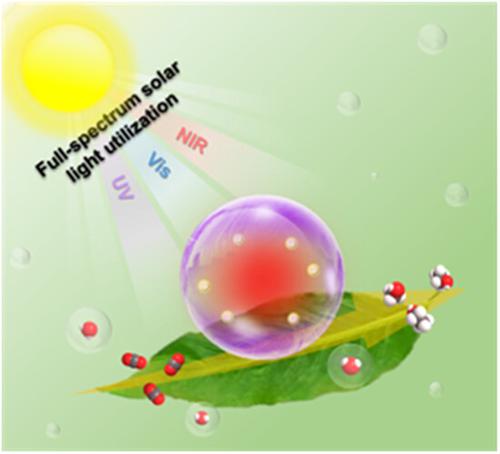当前位置:
X-MOL 学术
›
Carbon Energy
›
论文详情
Our official English website, www.x-mol.net, welcomes your feedback! (Note: you will need to create a separate account there.)
Construction of a Cu@hollow TS-1 nanoreactor based on a hierarchical full-spectrum solar light utilization strategy for photothermal synergistic artificial photosynthesis
Carbon Energy ( IF 20.5 ) Pub Date : 2024-02-21 , DOI: 10.1002/cey2.499 Sixian Zhu 1 , Qiao Zhao 2 , Hongxia Guo 1, 3 , Li Liu 1, 3 , Xiao Wang 1, 3 , Xiwei Qi 1, 3 , Xianguang Meng 3 , Wenquan Cui 1, 3
Carbon Energy ( IF 20.5 ) Pub Date : 2024-02-21 , DOI: 10.1002/cey2.499 Sixian Zhu 1 , Qiao Zhao 2 , Hongxia Guo 1, 3 , Li Liu 1, 3 , Xiao Wang 1, 3 , Xiwei Qi 1, 3 , Xianguang Meng 3 , Wenquan Cui 1, 3
Affiliation

|
The artificial photosynthesis technology has been recognized as a promising solution for CO2 utilization. Photothermal catalysis has been proposed as a novel strategy to promote the efficiency of artificial photosynthesis by coupling both photochemistry and thermochemistry. However, strategies for maximizing the use of solar spectra with different frequencies in photothermal catalysis are urgently needed. Here, a hierarchical full-spectrum solar light utilization strategy is proposed. Based on this strategy, a Cu@hollow titanium silicalite-1 zeolite (TS-1) nanoreactor with spatially separated photo/thermal catalytic sites is designed to realize high-efficiency photothermal catalytic artificial photosynthesis. The space–time yield of alcohol products over the optimal catalyst reached 64.4 μmol g−1 h−1, with the selectivity of CH3CH2OH of 69.5%. This rationally designed hierarchical utilization strategy for solar light can be summarized as follows: (1) high-energy ultraviolet light is utilized to drive the initial and difficult CO2 activation step on the TS-1 shell; (2) visible light can induce the localized surface plasmon resonance effect on plasmonic Cu to generate hot electrons for H2O dissociation and subsequent reaction steps; and (3) low-energy near-infrared light is converted into heat by the simulated greenhouse effect by cavities to accelerate the carrier dynamics. This work provides some scientific and experimental bases for research on novel, highly efficient photothermal catalysts for artificial photosynthesis.
中文翻译:

基于分级全光谱太阳光利用策略的Cu@hollow TS-1纳米反应器的构建用于光热协同人工光合作用
人工光合作用技术已被认为是CO 2利用的有前景的解决方案。光热催化已被提出作为一种通过光化学和热化学耦合来提高人工光合作用效率的新策略。然而,迫切需要在光热催化中最大限度地利用不同频率的太阳光谱的策略。在这里,提出了一种分层全光谱太阳光利用策略。基于该策略,设计了具有空间分离的光/热催化位点的Cu@空心钛硅沸石-1沸石(TS-1)纳米反应器,以实现高效光热催化人工光合作用。最佳催化剂上醇产物时空收率达到64.4 μmol g -1 h -1 ,CH 3 CH 2 OH选择性为69.5%。这种合理设计的太阳光分层利用策略可概括如下:(1)利用高能紫外光驱动TS-1壳上最初且困难的CO 2活化步骤;(2)可见光可以诱导等离激元Cu上的局域表面等离激元共振效应,产生热电子用于H 2 O解离和后续反应步骤。(3)通过空腔模拟温室效应将低能近红外光转化为热量,加速载流子动力学。该工作为人工光合作用新型高效光热催化剂的研究提供了一定的科学和实验基础。
更新日期:2024-02-21
中文翻译:

基于分级全光谱太阳光利用策略的Cu@hollow TS-1纳米反应器的构建用于光热协同人工光合作用
人工光合作用技术已被认为是CO 2利用的有前景的解决方案。光热催化已被提出作为一种通过光化学和热化学耦合来提高人工光合作用效率的新策略。然而,迫切需要在光热催化中最大限度地利用不同频率的太阳光谱的策略。在这里,提出了一种分层全光谱太阳光利用策略。基于该策略,设计了具有空间分离的光/热催化位点的Cu@空心钛硅沸石-1沸石(TS-1)纳米反应器,以实现高效光热催化人工光合作用。最佳催化剂上醇产物时空收率达到64.4 μmol g -1 h -1 ,CH 3 CH 2 OH选择性为69.5%。这种合理设计的太阳光分层利用策略可概括如下:(1)利用高能紫外光驱动TS-1壳上最初且困难的CO 2活化步骤;(2)可见光可以诱导等离激元Cu上的局域表面等离激元共振效应,产生热电子用于H 2 O解离和后续反应步骤。(3)通过空腔模拟温室效应将低能近红外光转化为热量,加速载流子动力学。该工作为人工光合作用新型高效光热催化剂的研究提供了一定的科学和实验基础。



























 京公网安备 11010802027423号
京公网安备 11010802027423号